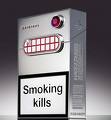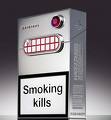London: Secondhand smoke is an “invisible killer”, according to a shocking new advertising campaign, launched by Public Health Minister Caroline Flint today. Nearly 85 per cent of tobacco smoke is invisible and odourless, but it causes just as much harm to people’s health as the smoke that is visible(i).
In the TV advert, which will be broadcast on UK TV from Monday 5 March, pervasive, dark smoke curls around guests at a wedding reception revealing the actual amount of smoke emitted by a single cigarette. And the smoker’s well intentioned attempts to blow or waft smoke away from non-smokers does not reduce the potential risk of secondhand smoke to health. The ads make this “invisible killer” visible in this family celebration. The TV commercial will be supported by press, online and outdoor advertising from 5 March.
Whilst most smokers and non-smokers believe secondhand smoke can cause harm, a new survey released today to support the campaign shows over half of smokers continue to smoke in a room with adult non-smokers, and a further quarter will still smoke when theyre near children(ii).
Secondhand smoke contains around 4,000 different chemicals. It can increase your chance of developing lung cancer and heart disease and can also cause a variety of serious health conditions including respiratory disease and cot death in children(iii). Its made up of both side stream smoke from the burning tip of the cigarette, and mainstream smoke exhaled by the smoker. Side stream smoke accounts for nearly 85 per cent of the smoke in a smoky environment and contains a much higher concentration of toxins, such as hydrogen cyanide, ammonia and carbon monoxide.
Launching the new campaign Public Health Minister Caroline Flint said:
“Smoking is harmful not just to smokers but to the people around them. What this new campaign brings home very clearly is the full impact of secondhand smoke. 85 per cent of smoke may be invisible and odourless but it is still damaging people’s health. Wafting and blowing away smoke may seem like the right thing to do but in reality, it makes little difference to the amount of secondhand smoke inhaled by people around you.
“With England going Smokefree on 1st July, there has never been a better time to stop smoking. We have already exceeded our three-year target to help 800,000 people quit by 2005/6, and still more and more people are successfully kicking the habit.
Professor Jarvis, University College London commented: Children are particularly affected by breathing the poisons in secondhand tobacco smoke, because their bodies are still developing. Their bronchial tubes and lungs are smaller and immune systems less developed, making them more vulnerable to the toxins in smoke. Despite smokers efforts to blow their smoke away, or to not sit near children, they are still causing harm. People need to see secondhand smoke for the invisible killer that it is.
Mikis Euripides, Asthma UKs Assistant Director of Policy & Public Affairs said: For people with asthma the effects of smoking can be deadly. 82% of people with this serious condition tell us that other peoples cigarette smoke triggers their asthma and many cannot go out to bars and clubs without the fear of a fatal asthma attack. About 800,000 people with asthma in England are also smokers themselves(iv), increasing their risk of asthma symptoms, asthma attacks and permanent damage to the airways.
The ads will run until 8th April coinciding with National No Smoking Day on Wednesday 14th March: nosmokingday.org.uk
The best way to protect your family and other adults from secondhand smoke is to stop smoking. For further information phone the NHS Smoking Helpline free on 0800 169 0 169. Smokers who want to quit can also find details of their local NHS Stop Smoking Service by visiting gosmokefree.co.uk texting GIVE UP and their full postcode to 88088 or asking at their local GP practice, pharmacy or hospital.
The NHS Smoking Helpline (0800 169 0 169) provides expert, free, and friendly advice to smokers and those close to them. Since its launch it has received over one million calls and a year after first calling the helpline, nearly a quarter of callers said they had successfully stopped and were still not smoking. Advisors can also refer callers to a local NHS Stop Smoking Service offering ongoing free face-to-face support and advice near their own home. There are over 170 throughout the country, offering a range of services including one-to-one meetings and group discussions with trained cessation advisors. Government research shows that smokers are up to four times more likely to stop successfully if they use their local NHS Stop Smoking Service together with NRT than they are if they use willpower alone.
Quitters can also sign up to a new website: justgiving.com/smokefree and quit smoking whilst raising money for a charity of their choice. The NHS also offers an interactive cessation support programme, Together, which helps smokers to quit by providing advice at key stages of the giving up process through a range of communication methods including email, text messages, mailings and phone calls.
Sources for statistics
(i) Chief Medical Office Annual Report 2003/US Surgeon General. The Health Consequences of Smoking: Chronic Obstructive Lung Disease, 1984.
(ii) 90% of UK population believes secondhand smoke can cause harm. However 56% smokers will still smoke in a room with adult non-smokers and 24% smokers will still smoke in a room with children. Research conducted amongst 1,600 adults aged 16-74 in England by BMRB’s Access Omnibus survey, Feb 2007.
(iii) Secondhand smoke increases the risk of lung cancer by 24% and heart disease
by 25%. Scientific Committee on Tobacco and Health (SCOTH) report, 2004.
(iv) 23% of adults with asthma in England are smokers (National Asthma Panel 2006) based on England adult population of 3.49 million with asthma



